Bottom Line Up Front:
I have three major goals for this post. First, to put into the ether of the internet easily accessible pictures of nuclear weapon equipment (preflight controllers) that are otherwise difficult to find. Second, to outline what this equipment does and how it is used based on primary sources and reasonable speculation. Finally, I want to reflect on the affective responses I (and some others) have had to nuclear weapon preflight controllers as material instantiations of preparation for nuclear war.
Author’s Note: Special thanks to Taylor Genovese and Grant Trent for helpful comments and revisions! Also special thanks to Althea Atherton for the picture of me poking the bomb!
If you want exclusive content, rewards, FUN, or just to support my work, please consider donating or joining:
https://www.paypal.me/nuclearanthro
https://www.patreon.com/nuclearanthro
A VERY Brief History of Nuclear Use Control
I am most familiar with the history of US nuclear weapon use control efforts beginning in the late 1950s and early 1960s. The scattering of US weapons across the world, including for delivery by allied NATO nations, was a significant driver for increased US civilian concerns about maintaining compliance with US law and preventing unauthorized nuclear use by allies. A popular anecdote has Harold Agnew visiting an airfield where he observed US nukes loaded on German planes, with German pilots, and a lone US sentry. Agnew asked the sentry what he would do if the pilot attempted to take off without authorization. The sentry replied that he would shoot the pilot but Agnew told him to shoot the bomb instead.[1] These worries and reports led JFK in 1962 to issue National Security Action Memorandum (NSAM) 160 which directed that PALs (at the time ranging from mechanical locks to electromechanical coded switches) be installed on all European theatre weapons. As of the early 1980s, approximately half of all US nuclear weapons deployed in Europe were secured only with mechanical combination locks.[2] Currently all 180 or so US nuclear weapons in Europe are fitted with coded-switch PALs that require six or twelve digit keys to unlock.
Encountering The Bomb
The preflight controllers I discuss in this post were (and some still are) used to set weapon delivery options and to unlock the Permissive Action Link (PAL) of the weapon on the ground. The PAL is (probably) a coded switch that, upon entry of the proper key, enables critical weapon circuitry.[3] Some planes, such as the B2, have the ability to both unlock nuclear weapon PALs and to set all fuzing options in flight and from the cockpit. Using the preflight controller, as I discuss below, nuclear weapons can be set to detonate at particular altitudes, at particular times, and at particular yields. In the first part of this post I am especially interested in the affective responses I have felt, and observed some others to have felt, upon encountering nuclear weapon use control equipment.
To paraphrase several comments made on Twitter, and by folk I have taken through the National Nuclear Museum of Nuclear Science and History (NMNSH), the preflight controllers for nuclear weapons seem more appropriate to a washing machine or an oven than to a nuclear weapon.
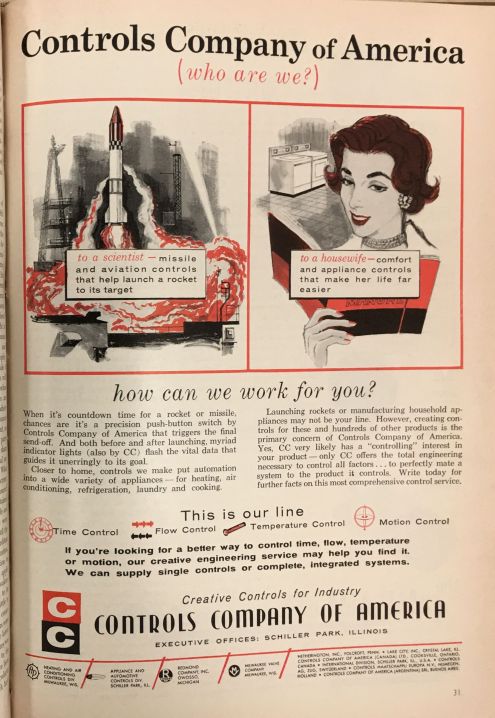
As an anthropologist, these moments of unease and experiences of the nuclear uncanny are fascinating points for productive analysis.[5] The occult and abstruse nature of information about nuclear weapons, just as for nuclear war, allows personal and cultural imagination great latitude in conceptualizing what these things are like.[6] There is relatively little opportunity for pesky reality to constrain our self-comforting beliefs about nukes.[7] For me, and at least some other folk, the seemingly apocalyptic nature of nuclear weapons demands that the procedures and machinery for their use should be appropriately solemn, complicated, and imposing. But they aren’t. In the United States at least, nuclear weapons were designed to be used and to be used certainly and rapidly in the event of authorization to do so. It is no mistake that preflight controllers resemble oven and washing machine controls; they were built with similar concerns for ease and quickness of operation.
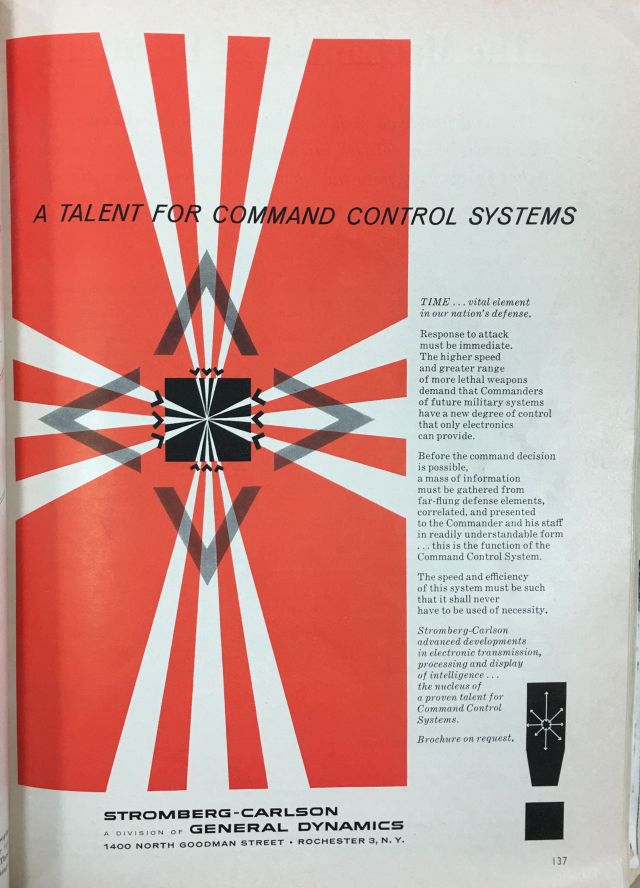
I would argue that the nuclear uncanny, that sense of discomfort and unsettlement, some of us feel when confronted with the banality of nuclear weapon use controls is of the same type I have observed (and felt myself) in discussions about US nuclear launch procedures. Again, secrecy and obscurity have contributed to, or at least allowed, the development of widespread folk beliefs about supposed restrictions on the authority of the President of the United States (POTUS) to order nuclear use. It appears, again by design, that POTUS has virtually unchecked authority to order the use of nuclear weapons.[9] The US nuclear command and control system, of which preflight controllers are a material metonym, has been purposefully constructed to be rapidly responsive to an authorized fire order. By definition, almost any nuclear launch order by POTUS is authorized.
Time for an illustrative anecdote! As part of a UNM Nuclear New Mexico class (Fall 2016), I was on a discussion panel after a public showing of the documentary Command and Control (the book is better).[10] To paraphrase, the discussion turned to US nuclear launch procedures. One person referred to my description as “simplistic” and argued that I failed to take into account the “checks-and-balances” on Presidential nuclear use but declined to elaborate what they are. It is difficult (for me at least) to repeatedly have these sorts of conversations and not conclude that some degree of what Robert Lifton called psychic numbing is in play: beliefs and emotional callouses that allow us to ignore, or at least reduce the impact of, the omnipresent threat of nuclear devastation.[11]
In any case, the next part of this post is the fun stuff: pictures and explanations! All pictures of preflight controllers and bombs are mine unless otherwise noted. ENJOY!
What Are Preflight Controllers and What do they Do?
Preflight controllers are the devices used by ground crew to set nuclear weapon delivery and yield options and to unlock the weapon before flight. Command Disable, for the weapons I discuss today, is also operated through the preflight controller. For some delivery aircraft, all of these options can be set using Aircraft Monitoring And Control (AMAC) system equipment located inside the plane; for other aircraft these options had to be set on the ground before flight. Based on my readings of declassified documents and secondary sources, this is my best guess for what these dials and buttons do:[12]
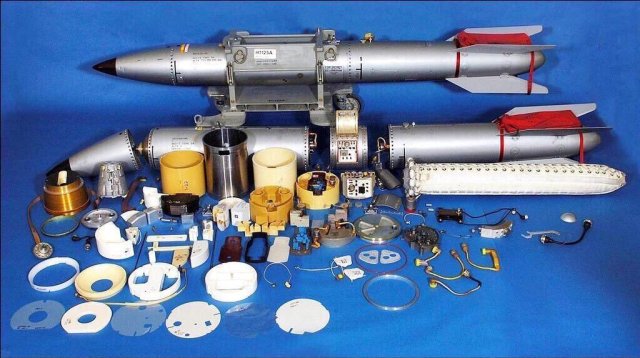
The B61 nuclear gravity bomb is now present in the US arsenal in mods -3, -4, -10 (so-called “tactical” versions); mod -7 (“strategic”); and mod -11 (earth penetrating).[14] Currently the B61 Life Extension Program (LEP) is in the process of converting B61-4 weapons into the B61-12 which will have four yield options between .3kt to 50kt. Most importantly, the B61-12 will ditch the parachute in favor of a precision guided tail kit. Supposedly all other mods of the B61, and the B83, will be retired afterwards. In this post, I discuss the preflight controller for two retired versions of the B61: the -0 and the -5. I start with the B61-5 because it is the most similar to controllers still used and also has helpful labeling.
B61-5

I swear, the B61-5 is like the embarrassing relative nobody likes to talk about after they die. That is to say, I have had significant difficulty finding basic information about the B61-5 other than its yield options and that there were plans to convert it into B61 mods -6, -8 (both canceled). Based on my readings of declassified documents, the driving forces behind new B61 mods have included the desire for additional units (-1), different yield options, specialty missions (-7, -11), because the US didn’t want to dismantle warheads from other systems (-10), and for safety and fuzing upgrades. All of that said, this discussion starts at the upper left of the preflight controller and goes counter-clockwise for each point of interest.
TA, TB: 10-69
Planes in flight are, unsurprisingly, rather sensitive to nuclear detonation effects and the B61 was designed to allow delivery by low-flying aircraft. The TA/TB switches are for setting “two independent aircraft safe escape times” that must elapse before the weapon can go boom thus giving the delivery vehicle time to get away.[15] The range is from 10 to 69 (nice) seconds and the aircraft crew selects between TA and TB using equipment in the plane.
J2
This is the port for a strike enable plug that must be inserted to make the weapon usable. My understanding is that the plug completes a pathway for internal power systems.
DELIVERY: FF or RE
This selects between freefall and parachute retarded delivery. The crew selects the
laydown delivery option using AMAC equipment.
OPTION: A, B, C, D, E, F
Most B61 mods have multiple selectable nuclear yields providing a “Dial-A-Yield” (DAY) function. Although there are six choices, the OSINT I can find gives only four for any given mod of the B61. As far as I can determine, the B61-11 earth-penetrating weapon only has one yield (400kt). The B61-5 could go between 10-150kt which is suspiciously similar to the W80 warhead.[16]
DELAY: G, H, J
For parachute-retarded deliveries this sets a delay between weapon release and parachute deployment: G=.3 seconds, H=.6 seconds, J=1.6 seconds. In addition, or perhaps “instead,” for laydown deliveries this sets a delay between weapon impact on the ground and detonation: G & H=30 seconds and J=80 seconds. In the unlikely event that you ever find yourself nearby a nuclear weapon that has drifted to ground on a parachute, then I would suggest that you very quickly come to terms with your own mortality.
COMMAND DISABLE SYSTEM: A, B, & C dials (0-9); T-handle; dial with N, CC, DI, & R
As previously mentioned, the US has a habit of scattering nuclear weapons around the globe and then civilian leadership worrying about enemies, terrorists, or allies seizing the weapons and using them. PALs were initially, and presumably still are, conceptualized as a delay mechanism and so is command disablement. In the event that, say, US nuclear weapons stored at Incirilik AFB in Turkey are threatened with capture during a coup (impossible to imagine, I know) then the command disable allows for, well, disablement of the weapon. Put in the correct 3 digit code, spin the knob to ‘DI,’ (for disable!) and pull on the T-handle and a thermal battery powers up to (probably) fry some crucial part of the circuitry.[17] Now you have to return the weapon to Pantex in Texas for remanufacture. Alternatively, you can maybe just dig the plutonium out and make your own but that’s a pain in the ass and there is maybe (maybe not) an active protection system that violently (think one-point detonation) punishes penetrations of the tamper resistant membrane. Declassified documents I have seen are rather quiet on the whole thing but this is not a totally unreasonable possibility under some conditions I feel. Like the PAL itself, command disable will buy you some time but it probably isn’t a foolproof safety mechanism. Best not to let nuclear weapons escape your control.
J1
Permissive Action Link (PAL) plug. This is where a connector cable for ground control equipment to lock/unlock, recode, and check the status of the bomb. PALs are probably coded switches attached to the X-unit or other critical circuitry. Without input of the proper key to the PAL the weapon will not detonate.[18] Some planes have Aircraft Monitoring and Control (AMAC) equipment able to manage PAL functions; for other aircraft the weapon must be unlocked on the ground before flight.
B61-0
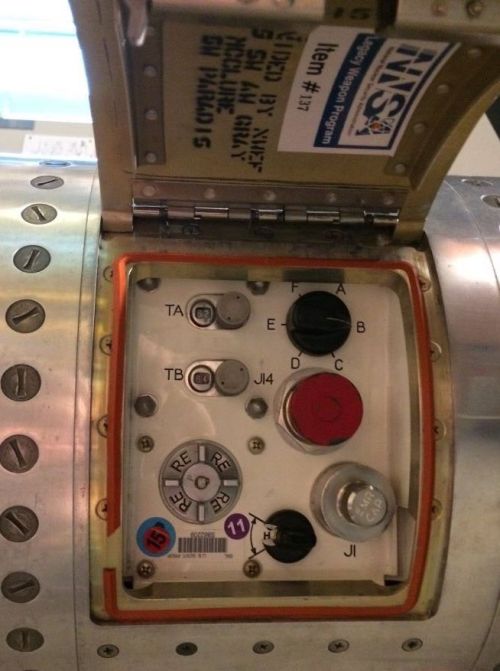
For the B61-0 (the original B61 bomb), everything probably works the same EXCEPT you will note the absence of a Command Disablement system. I am unsure as to when command disable became a standard part of B61 design and deployment.
B83
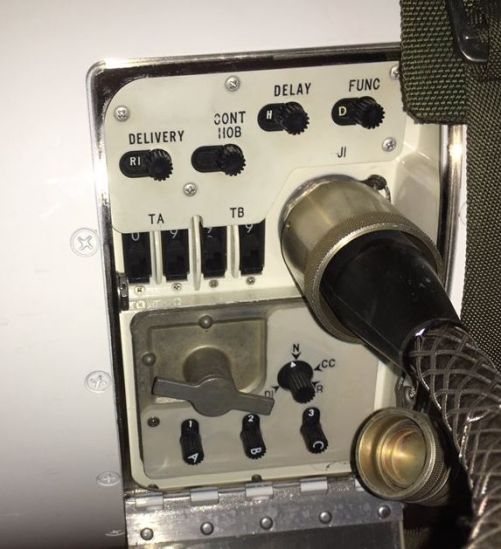
The B83 is the only remaining megaton class (1.2MT) nuclear weapon the US deploys. As a FUFO (Full Fuzing Options) weapon, like the B61, it has more choices than a casino buffet. My discussion begins at the top and moves from left to right starting with “DELAY.”
DELAY: G, H, J
Time after weapon release that the parachute deploys or, for laydown delivery, time after the weapon impact before detonation.
FUNC: A, B, C, D, blank, blank
Presumably this is the Dial-A-Yield selector. Maximum yield for the B83 is 1.2 megatons but I have not seen much on other available yields. I find it interesting that the B61-0, -5 preflight controllers I have seen have six options whereas this B83 controller has four with two dial positions left blank.
DELIVERY: FF, R1, R2
The B83 has more fuzing options than Papa Johns does pizza choices. FF is “free fall” presumably and “R” refers to “parachute retarded.” I am not certain of the difference between “R1” and “R2.’ My first guess would be that R1 and R2 are airburst vs ground burst but this is open to question in light of the existence of the CONT/HOB dial.
CONT/HOB: CL, PL, PH, CH
I assume this allows for setting the weapon to a contact or airburst or laydown delivery. I have almost no clue what “CH,” “CL,” “PL,” and “PH” mean. ‘H’ might stand for ‘high’ and ‘L’ might stand for ‘low?’ Additionally, I am unsure where the actual height of burst would be set if this fuzing option were selected but presumably in the cockpit using AMAC. Setting an exact height of burst is desirable since it allows for maximization of the area covered by particular blast overpressures.
TA, TB
This option codes a minimum safe separation time that must elapse after the weapon has been released from the aircraft before it can detonate. Safe separation time is set by neat tabs that you click up or down. Although they go from 00-99 (10s and 1s switch), the actual time that can be set may not go all the way up to 99 seconds. For example, on the canceled B61 -6, & -8, the TA/TB could be set up to 99 but the max time was 69 seconds.[19]
J1
This is the plug for the PAL equipment to lock/unlock the weapon, check status, etc. For some planes, like the B2, the Aircraft Monitoring and Control (AMAC) system allows for all of these options (and weapon unlock) to be accomplished from the cockpit. The AMAC plug is on the top of the weapon. At the NMNSH the B83 is displayed with the T1563 PAL controller and T1571B power supply; the cable visible in my photo of the preflight controller is attached to the controller.

COMMAND DISABLE SYSTEM: A, B, C (0-9); T-handle; dial with “N,” “CC,” “DI,” and “R”
Setting the A, B, C dials to the proper code, rotating the other dial to “DI,” and pulling the t-handle fires up a thermal battery located in the preflight controller that then does…something… that non-violently disables the weapon. Based on documents I have seen, the effect is almost certainly within the “protected volume” of the weapon and quite possible within the nuclear subsystem itself. Guesses range from melting detonators to setting off small explosive squibs that guillotine vital firing circuitry.
WE177 Ground Control Unit
The WE177 was a UK nuclear gravity bomb deployed, in three major versions, between 1966 and 1998 and pictured below.[20] Apparently, the functional equivalent to the US preflight controller is quaintly named the “Ground Control Unit.”
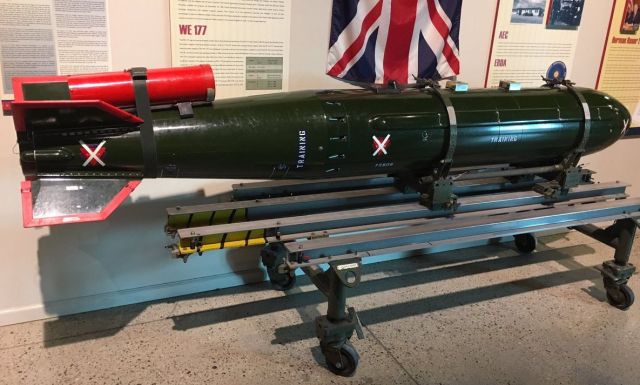
The GCU is a fun comparison to the US controllers. Notably absent are things like a command disable system and a PAL controller plug. In fact, as I will discuss below, physical use control for this weapon was based on what amounts to a bike-lock key. Starting at the top left and going clockwise the GCU options were:[21]
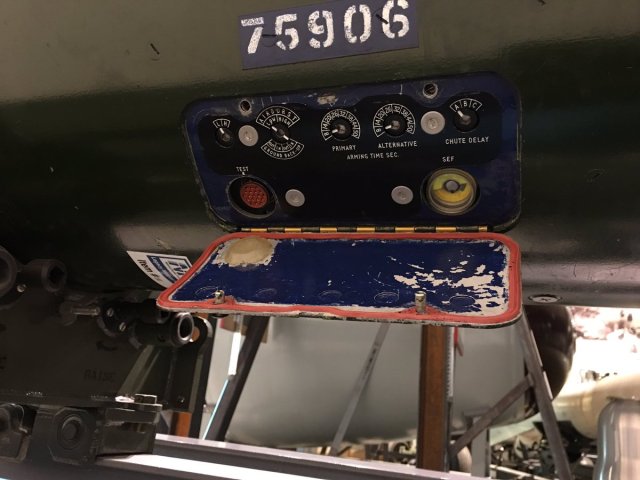
“L”, “H”
The WE177A was the only version with a selectable yield. “L” (for low?) would have been .6kt and “H” 10kt. At the .5kt selection the WE177A would have been used as a nuclear depth bomb.[22]
“AIRBURST/GROUND BACK-UP”: “LOW,” “HIGH”; “OUT,” “IN,” “OUT,” “IN”
As with the B61, the WE177 could be delivered parachute retarded or freefall; this dial also allowed the selection of “salvage” fuzing for a ground burst in case airburst fuzing failed. Interestingly, at least for some B61 mods, non-detonation upon impact could not be assured for a weapon that failed to detonate as an airburst but for which salvage fuzing was not enabled.[23]
ARMING TIME SEC., PRIMARY & ALTERNATIVE: 8, 14, 20, 26, 32, 38, 44, 50
Legend has it that these specific times were selected by the Queen herself! Just kidding, but in the absence of a more logical or credible explanation as to why the UK did it this way, it’s the reason I’m going with. Brian Burnell describes this option as setting a delay between when the weapon is released from the aircraft and when the radar fires up; this allows the plane time to escape and reduces the period for potential enemy jamming. I am unsure if this, like the B61 safe-separation timer presumably does, sets an absolute bar to detonation before the full time has elapsed. In other words: if the WE177 were fuzed for a freefall airburst with a radar delay of 50 seconds, and with contact salvage fuzing enabled, would the bomb detonate if dropped at an altitude where the weapon impacts the ground before the chosen 50 second delay has passed? It seems likely to me (at least if the British were sensible about these things) that the ARMING TIME is equivalent to the B61 safe separation time and the delay in radars turning on is part of an overall senescence of the arming system.
CHUTE DELAY: A, B, C
This dial set a time delay between weapon release from the aircraft and parachute deployment.
SEF: “Strike Enable Facility”
As a final step in arming the WE177, ground crew inserted what looks like a bicycle lock key (pictured below) into this plug and turned. Bingo, weapon ready to go. No coded switches or dual-key system although the weapon fuzing and firing circuitry included environmental sensing devices.
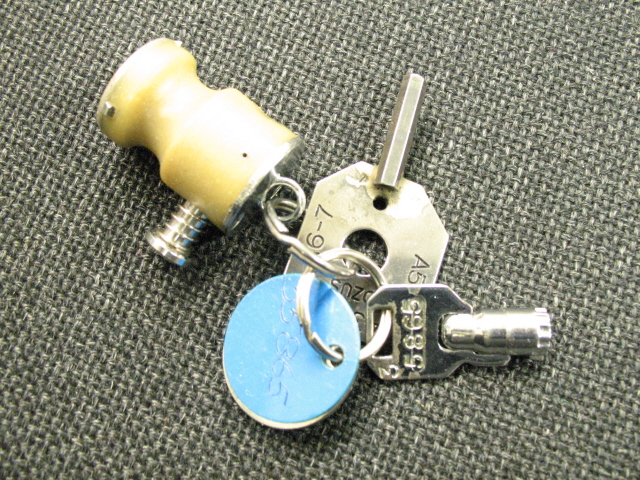
TEST
I assume this port was for ground equipment to check weapon status, power, etc.
Concluding Thoughts
I hope you have enjoyed this discussion. Verified pictures of the B61-5 preflight controller are, I believe, my one small original contribution to OSINT about nuclear weapons. If you have additional primary sources, or ideas about the unknown (to me) bits, please share! As a final thought I would note that US nuclear deployments and levels of readiness are relative outliers. China, India, Pakistan, and (probably) Israel don’t keep nuclear weapons mated to delivery systems. Only the US and Russia currently deploy a fully functional triad+ of delivery systems and Russia has traditionally maintained a lower readiness posture than the US. Furthermore, the US is unusual, and maybe unique, in the extreme degree of autonomy it endows a single person with regards to the use of nuclear weapons. It is long past time that we reconsidered both our nuclear force structure and the institutional arrangements that allow one person the power to end the world as we know it.
Endnotes
[1] Huard, “When to Shoot a Nuclear Bomb with Your Gun,” 2015.; Stein & Feaver, Assuring Control, 1987.
[2] “PAL Control of Theatre Nuclear Weapons,” 1984.
[3] Bellovin, “Permissive Action Links,” 2017.; Bradbury & Schwartz, “NATO Weapons,” 1961.; Sandia, “PAL Control of Theatre Nuclear Weapons,” 1984.
[4] Controls Company of America, “Who Are We,”1959: 31.
[5] Masco, Nuclear Borderlands, 2006.
[6] Derrida, “No Apocalypse, Not Now,” 1984.
[7] Lifton & Falk, Indefensible Weapons: The Psychological and Political Case Against Nuclearism, 1982.
[8] Stromberg-Carlson, “A Talent for Command Control Systems,” 1960: 137.
[9] Wellerstein, “The President and the Bomb, Part III,” 2017.
[10] Kenner, “Command and Control,” 2016.
[11] Lifton & Falk, Indefensible Weapons: The Psychological and Political Case Against Nuclearism, 1982.
[12] Glenn, “B61 Nuclear Bomb,” 2010.; Sandia, “Interim Development Report,” 1989: 29, 35, 57.
[13] Honestly, I am not sure how to cite this photograph. I have seen low-rez versions of it in declassified documents and Wikimedia commons but I am unsure of the provenance of this higher resolution version.
[14] Kristensen and Norris, “B61 Family,” 2014.
[15] Sandia, “Interim Development Report,” 1989: 29.
[16] Kristensen and Norris, “B61 Family,” 2014.
[17] Sandia, “Interim Development Report,” 1989: 29, 35, 57.
[18] Bellovin, “Permissive Action Links,” 2017.; Bradbury & Schwartz, “NATO Weapons,” 1961.; Sandia, “PAL Control of Theatre Nuclear Weapons,” 1984.
[19] Sandia, “Interim Development Report,” 1989.
[20] Burnell, “WE.177,” 2016.
[21] I am indebted to Brian Burnell’s outstanding webpage for discussion of WE177 GCU.
[22] Burnell, “WE.177,” 2016.
[23] Sandia, “Interim Development Report,” 1989.
[24] Burnell, “WE.177,” 2016.
Works Cited
Bellovin, Steven M. “Permissive Action Links.” https://www.cs.columbia.edu/~smb/nsam-160/pal.html#CAH84, 2017. Accessed 06/12/2017.
Bradbury, Norris K., and Schwartz, G. P. “NATO Weapons.” AW-765, Memo to General Starbird. https://www.cs.columbia.edu/~smb/nsam-160/pal-design.pdf, January 5, 1961. Accessed 06/07/2017.
Burnell, Brian. “We.177.” Nuclear Weapons: A Guide to British Nuclear Weapon Projects. http://nuclear-weapons.info/vw.htm#WE.177, 2016. Accessed 06/17/2017.
Controls Company of America. “Who Are We.” Scientific American 200, no. 4 (1959): 31.
Derrida, Jacques. “No Apocalypse, Not Now (Full Speed Ahead, Seven Missiles, Seven Missives).” Translated by Catherine Porter and Philip Lewis. Diacritics 14, no. 2 (1984): 20–31.
“Glenn.” “B61 Nuclear Bomb Preflight Controller.” Glenn’s Computer Museum. http://www.glennsmuseum.com/controller/controller.html, 2010. Accessed 06/12/2017.
Huard, Paul Richard. “When to Shoot a Nuclear Bomb with Your Gun.” War is Boring. https://medium.com/war-is-boring/when-to-shoot-a-nuclear-bomb-with-your-gun-f1f97093a64e, January 30, 2015. Accessed 06/16/2017.
Kidder, R. E. “Report to Congress: Assessment of the Safety of U.S. Nuclear Weapons and Related Nuclear Test Requirements.” UCRL-LR-107454. Lawrence Livermore National Laboratory: Livermore, CA. https://fas.org/programs/ssp/nukes/testing/kidderucrllr107454.pdf, July 26, 1991. Accessed 06/12/2017.
Joseph Masco. The Nuclear Borderlands: The Manhattan Project in Post-Cold War New Mexico. Princeton: Princeton University Press, 2006.
Kenner, Robert. “Command and Control.” Film. Robert Kenner Films, 2016.
Kristensen, Hans M., and Robert S. Norris. “The B61 Family of Nuclear Bombs.” Bulletin of the Atomic Scientists 70, no. 3 (2014): 79-84.
Lifton, Robert J., and Robert Falk. Indefensible Weapons: The Psychological and Political Case Against Nuclearism. New York: Basic Books, 1982.
Plummer, David W., and William H. Greenwood. “The History of Nuclear Weapon Safety Devices.” SAND-98-1184C. Sandia National Laboratories: Albuquerque. https://www.osti.gov/scitech/biblio/671923, 1998. Accessed 06/07/2017.
Sandia National Laboratories. “Interim Development Report for the B61-6,8 Bombs.” SAND88-2986. Sandia National Laboratories, Albuquerque. https://nnsa.energy.gov/interim-development-report-b61-68-bombspdf-3714kb, 1989. Accessed 06/12/2017.
Sandia National Laboratories. “PAL Control of Theatre Nuclear Weapons.” SAND82-2436. Sandia National Laboratories: Albuquerque. https://www.cs.columbia.edu/~smb/nsam-160/Theater_Control/Theater_Control.pdf, 1984. Accessed 06/07/2017.
Stein, Peter and Peter Feaver. Assuring Control of Nuclear Weapons: The Evolution of Permissive Action Links. Lanham: CSIA Occasional Paper Series, 1987.
Stromberg-Carlson. “A Talent for Command Control Systems.” Scientific American 202, no. 1 (1960): 137.
Wellerstein, Alex. “The President and the Bomb, Part III.” Restricted Data: The Nuclear Secrecy Blog. http://blog.nuclearsecrecy.com/2017/04/10/president-bomb-iii/, April 10, 2017. Accessed 06/07/2017.
Wolfgang, Raymond B. “The Enhanced Nuclear Detonation Safety Theme – an Introduction.” SAND2012-0793C. Sandia National Laboratories, Albuquerque. https://www.osti.gov/scitech/servlets/purl/1090221, 2012. Accessed 06/12/2017.

You are probably one of the few to cite Derrida in a blog post about nuclear weapons. 😉
It’s relevant!
I think it’s underutilized but also not entirely correct either. Glad you enjoyed the reference!
Funny that the only comments so far are about Derrida (I was about to post mine then saw the one above.)
I was going to say “Ah! That Derrida article. One of my favorites!” – and I am mid-blog post too and will also be citing it, should other commenters be interested 🙂
Good post, as always!
I’d wish that you’d tell us how you feel instead of telling us you had an “affective response”.
Fair enough!
It’s really complex for me. There’s a level of appreciation and excitement for getting to see and touch something that relatively few have. And it creeps me out because it’s like using an oven or a washing machine. The use control does not match my appreciation for what that device can do.
I’m not so sure; I like “affective response” because I think it bridges the gap between personal reactions & academic ones.
as for the washing machines, have you read O’Gorman & Hamilton on technical operators? They’re very good. They have 2 pieces (afaik) on it; one is in a journal, it’s called “At the Interface” and the other is in a book about visual rhetoric, it’s called “The Diffusion of a Nuclear Icon” I think. I can send you the citations, I think you’d find them interesting. I’ve cited them a fair bit (they’ve also written about film & the “Super” – I really enjoy their work)
I will read them now! Thank you for the suggestions.